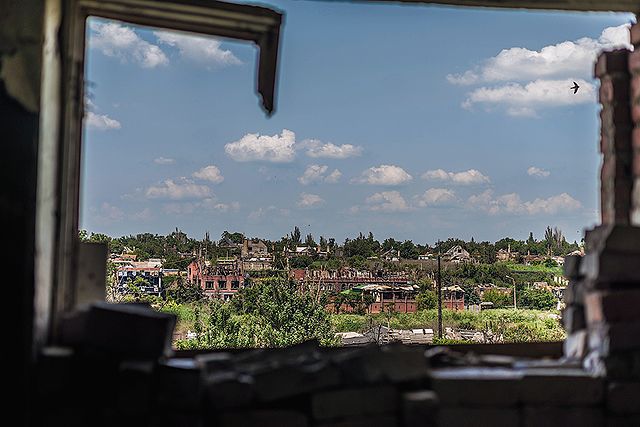Russia’s full-scale invasion of Ukraine in 2022 is one of the most monitored conflicts in the history of warfare. From remote sensing satellite imagery to signals intelligence to social media monitoring, copious data are being collected and analyzed in real time. In particular, a substantial amount of attention is focused on the environmental impacts and implications of this war.
The environmental risks at play, including nuclear contamination, highlight the complex threats that exist in most industrialized societies. Ukraine’s experience from Chernobyl radiation was further compounded by contaminated and polluted industrial sites. Linked to its Soviet heritage as a producer of heavy industry, the country’s air pollution emissions from metallurgical and coal industries were widespread, and hazardous waste and toxic emissions posed a challenge connected to the energy sector.
Over time, however, Ukraine made concerted environmental strides. Our research showed a relatively robust environmental management system had been established prior to 2014. When Russia attacked Ukraine that same year, warfare in key areas (primarily in eastern Ukraine) undermined progress made; the environmental management system significantly worsened after Russia’s full-scale invasion in 2022.
Of particular concern: A human and environmental disaster could occur from direct sabotage or accidental bombing at the Zaporizhzhia nuclear power plant, with the possibility of releasing unprecedented nuclear contamination. Some analysts have questioned this likelihood, but a longstanding disruption to environmental management, coupled with Moscow’s willingness to raze at least 13 Ukrainian cities, leave room for doubt. During Russia’s failed attempt to invade from the north, forces also stirred up radioactive dust at Chernobyl, the site of the world’s worst civil-nuclear disaster in 1986.
Russia’s onslaught of Ukraine has consistently targeted civilian infrastructure, leaving behind a legacy of both direct violence and environmental impacts. Mariupol was a seaside city of approximately 450,000 people that nearly suffered total destruction by Russian forces in 2022. The Azovstal industrial plant, one of Europe’s largest steel works, was also targeted by Russia that same year. More recently, the destruction of the Kakhovka dam ushered in serious short- and long-term environmental consequences: The region’s Askania Nova—Europe’s largest steppe— was impacted, endangering many native plants and animals (e.g., the native zebra population) and threatening fragile ecosystem balances.
This war compounds a range of costly and risky environmental damage ranging from destroyed tanks and armored cars, to burned vehicles, to demolished factories, buildings and infrastructure. Most of this damage has been captured and tallied by the EU-sponsored open verified data platform EcoZagroza.
The implications of the environmental disaster wrought by the Russian Federation are numerous. Prior to Russia’s full-scale invasion, Ukraine faced substantial risks by maintaining (rather than remediating) environmentally fragile sites after Russia’s initial 2014 invasion. These sites have since incurred significant warfare damage, and the potential impact of extreme weather (due to anthropogenic climate change) further threatens them.
Environmental destruction in Ukraine affects food security, both in-country and for territories far beyond its borders. Decreased food production—coupled with emissions produced by vehicles and burning, war-damaged fuel depots and buildings—hinders Ukraine’s stability and escalates human health concerns, with repercussions for human security at a global level.
Warfare damages the environment, whose unique ecological battle scars leave an enduring legacy often unassessed when the shooting stops. In Ukraine, mapping the complex pathways of destruction gives us new ways to analyze and quantify such damage.
Looking to the future, these environmental impacts also provide insight on rebuilding, with a particular focus on adaptation rather than a return to the status quo ante. Despite the horrific impacts of Russia’s war on Ukraine, a recent study noted positive trends in net air quality linked to a reduction in chemical, steel, and energy factories. While restoring Ukraine’s economy is an important reconstruction goal, creative solutions to consolidate positive air quality trends is also a worthy objective, ensuring that the rebuild is ecologically and economically sustainable. Agreements and standards to monitor the safety of nuclear power plants are also critical. Hard security measures for nuclear sites and their staff will be needed to prevent similar terror attacks from being attempted in Ukraine or elsewhere.
As criminal prosecution of Russian leadership for this unprovoked war moves forward, environmental data may play an important role in criminal and civil litigation, especially given the UN’s recent adoption of the Protection of the Environment in Relation to Armed Conflict (PERAC) principles. Ukraine’s pursuit for environmental justice may also lead to new legal precedents in the international system for prosecution of “ecocide,” which includes the mass destruction of the environment, fauna, or flora; water pollution; and other actions deemed as contributors to environmental catastrophe.
Download a PDF of this issue »
Listen to a podcast with the editors from this issue »
Written by Drew Marcantonio (Ph.D. ’21), Department of Management & Organization, Mendoza College of Business, and Faculty Fellow, Kroc Institute for International Peace Studies, University of Notre Dame; and Kristina Hook (Ph.D. ’20), Assistant Professor of Conflict Management, School of Conflict Management, Peacebuilding, and Development, Kennesaw State University.





